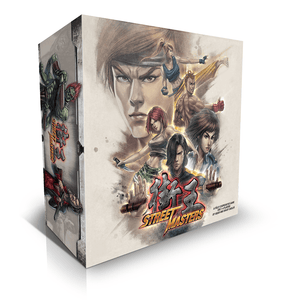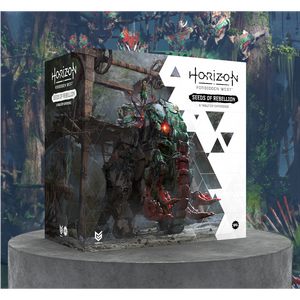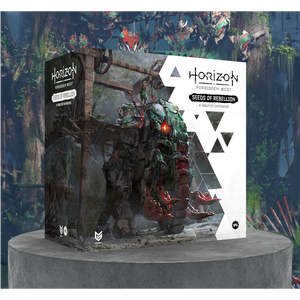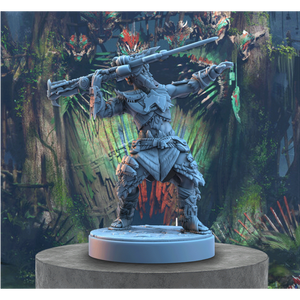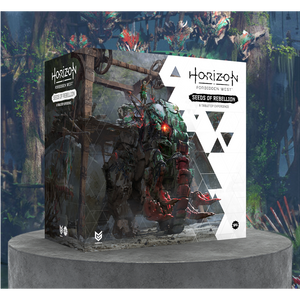We’re creeping ever closer to the Resident Evil: The Board Game Kickstarter launch on October 26 and, with it, our first foray into the Spencer Mansion as an open world campaign.
But before we can set food inside that sinister place — the place where Umbrella’s horrific experiments first broke loose — we’d better prepare with some gameplay blogs.
We’ve already met Rebecca Chambers in Character Design and covered the gameplay basics in the How to Play blog.
Now, Sherwin Matthews, Lead Designer, is here to tell us about some of the brand new mechanics you can expect in Resident Evil: The Board Game — mechanics you won’t have experienced even if you’ve already played the Resident Evil 2 & 3 board games.
Starting, of course, with exploration and encounters....
(Resident Evil: The Board Game will be the third board game release but first in the timeline, based on the 2002 REmake of the original video game. More on that here.)
New Exploration Mechanics in Resident Evil: The Board Game
by Sherwin Matthews
Welcome back, Survivors. I hope you’re all well, and starting to feel that tingling sense of excited dread for the upcoming Kickstarter campaign. I know I am.
As we touched on in the last post, one of the strongest elements in the Resident Evil video games is not knowing the way forward, slowly building out the map as you explore.
Each step should be one into the unknown, to replicate the sense of uneasy dread from the video game.
In the Resident Evil 2 and Resident 3 board games, we introduced the unexpected by using fixed tile layouts that were set up at the start of each scenario, with encounter tables to randomise the enemies that would be waiting.
That worked very well and gave us a lot of control over the length and experience of the scenario — but it also meant setup could take longer than we’d like.
Resident Evil 3: The Board Game significantly reduced this setup time compared to its predecessor by switching most cards to living decks instead of unique decks for each scenario. Still, we wanted to do more.
And then, as with all things, necessity prompted innovation… and we found ourselves refining an older idea I’d had all the way back when I was prototyping Resident Evil 2: The Board Game, four years ago.
What’s New About Exploration in Resident Evil 1?
Scenarios in Resident Evil: The Board Game begin with a very small number of tiles, often three or four at the most. To flesh out your map, you’ll need to use doors that lead off the playing area.

As you can see, each door that leads to places unknown is numbered, indicating which card from the exploration deck should be flipped to reveal the areas beyond.

When this happens, you’ll add the tiles, tokens, and any enemies shown on the card, and then resume exploring.

This system not only speeds up setup but also means you never quite know what to expect. Areas are deliberately kept to a small size, both to avoid too much interruption and to create a zoomed in and personal sense of exploration at the start of each scenario.
What Should You Expect?
A card might reveal a corridor with several rooms breaking off from it, the only question being what awaits in each of the rooms. Or, it could be a single room with more doors that lead into the unknown.
It might even be a dead-end with a horde of enemies waiting to attack... or show a locked door that will force you to backtrack in search of a key.
As you may already have realised, the new exploration system means you can’t plan your routes anywhere near as easily as in the previous board games. You’ll need to explore first, adapting your plans as you go. Every door you step through has the potential to threaten your carefully-laid plans (and your life…).
If you’ve played any of the previous board games, you may also have realised that not having the map laid out from the start means you don’t know where the typewriters are from the beginning.
As a quick reminder, your tension deck acts as a timer. If the deck runs out, your time is up, and you’ll be abandoned to your grisly fate in the mansion… unless you can find a typewriter to refresh the deck.
Don’t expect to memorise layouts for next time, either. Although the mansion does have a set layout, it’s entirely possible you won’t see a full area the first time you attempt a scenario. The Spencer Mansion is a maze full of locked doors and deadly enemies to block your path.
Sometimes, you’ll have no choice but to abandon the scenario at hand and go searching for another way around — Resident Evil: The Board Game is a campaign game, after all — or find yourselves starting the scenario from an entirely different set of tiles, as you arrive through a series of secret passages to an area that was previously hidden…
Of course, tiles and exploring them are only half the story — because we haven’t just re-designed the exploration system, but the enemy encounter tables, too.
New Enemy Encounter Mechanics
When you first begin a Resident Evil video game, you’re taking a step into the unknown. The classic Resident Evil video games are typically claustrophobic affairs in confined spaces, the way ahead hidden behind a series of closed doors you’ll need to explore your way through.
And then, there’s the enemies. They, too, add to this sense of uncertainty. As the door creaks open, you find yourself nervously holding your breath, not only wondering what room awaits, but also what could be lurking within...
...And this feeling never quite goes away. You quickly learn to assess your immediate surroundings and stay on your guard. A faint groan betrays a zombie swaying unsteadily around the corner; a splinter of glass is a tell-tale sign of the Cerberus that’s about to launch itself through a window.
Naturally, we wanted to keep you guessing in the board games, too.
Enemies in the Previous Resident Evil Board Games
The tension deck was one way to achieve that feeling of... well, tension. Especially with those four-legged foes. But we also needed a system for placing enemies.
Starting with all enemies in play was definitely out. One or two zombies is good for setting a scene, or guaranteeing a specific interaction, but that’s about as far as we wanted to go.
Keeping the enemies fixed but as hidden information was equally as underwhelming. The first time players experienced the game they were nervous, but that quickly passed on repeated playthroughs.
So, we introduced encounter tables.
Encounter tables were useful tools, each offering six different outcomes for any given room. We were able to theme them to each scenario depending on difficulty and/or if we had a particular story to tell (I’m looking at you, R.P.D. morgue), and create specific tiles with heightened tension.
Thanks to encounter tables, you’d never feel quite in control or know what to expect, keeping you on the edge of your seat.
So, why change it for Resident Evil: The Board Game?
What’s New About Enemy Encounters in Resident Evil 1?
When we moved toward the new exploration system detailed above, we not only achieved our goal of creating a more tense and unpredictable exploration experience, but also streamlined setup by some considerable margin.
This got me thinking.
In Resident Evil 3: The Board Game, we’d introduced the idea of an evolving tension deck influenced by player decisions during narrative events, the city danger level, and individual scenarios. It worked extremely well and turned out to be pretty popular with players, too.
So, what if we did the same for enemies?
Instead of an encounter table, we could create a deck of cards — some with enemies, others with special rules, and a couple of blanks.

And then, rather than breaking you away from the action to roll on tables, we could codify every room to determine how many of those encounter cards you’d have to draw when entering.

For starters, this meant we could move away from worrying about making each encounter table unique — trust me, over forty scenarios, this was no mean feat — and could instead concentrate on creating the desired effects for a scenario.
It also let us create persistent effects that would stay with you in future scenarios. Like the tension deck, the encounter deck is now a living, breathing deck of cards that’s added to as your campaign continues, becoming more and more dangerous.
We can even modify the deck during games with effects, to increase the chance of meeting enemies (or not…).
And on that note we come introducing new enemies, and narrative events. I won’t say too much, but think very carefully about whether you should stop to burn bodies or not. Your choice might come back to bite you. Literally.
And my advice is to definitely think twice about entering new areas when the Crimson Head Prototype or Lisa Trevor are about.
…wait, the Crimson Head Prototype can escape into the Mansion?!
That’s all from me until next time, folks!
Hopefully this has only served to fan the flames of excitement, rather than leave you hiding in a safe room, too scared to leave and explore some more.
And speaking of exploring, here’s your first pathway:
If you’re not yet following the Kickstarter campaign, go to Kickstarter and hit 'Notify me on launch'!
 Join us on Discord
Join us on Discord


